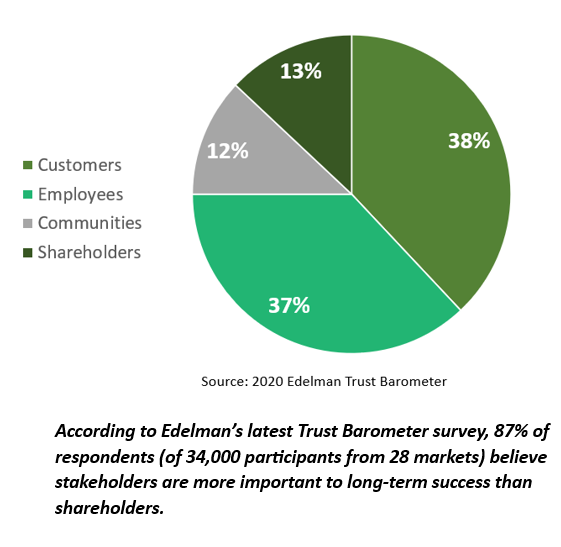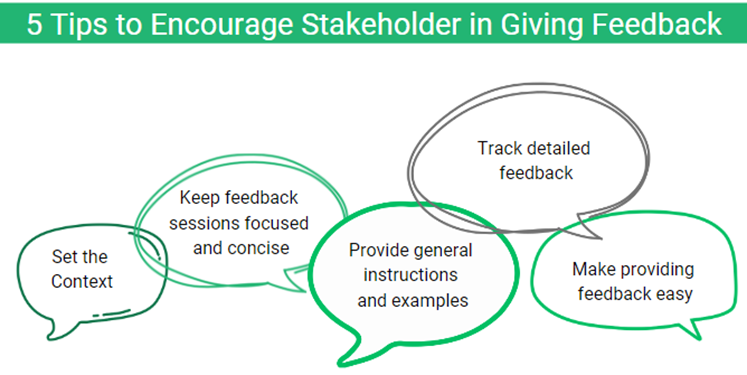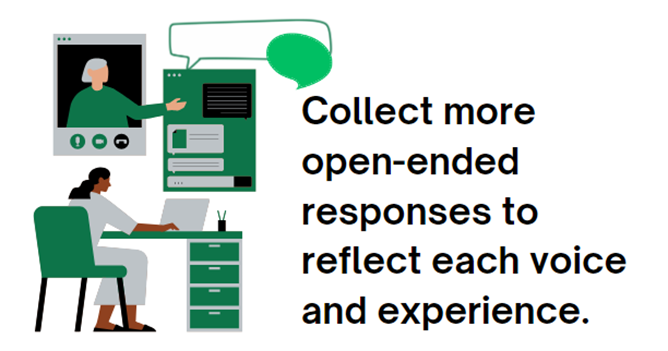
Have you ever wondered why some projects effortlessly reach success while others seem to stumble aimlessly? It's a question that echoes through boardrooms, executive offices, and virtual meetings, prompting thoughtful consideration among stakeholders of various stripes, all united by a common goal— project success. In the ever-evolving arena of contemporary commerce, successful leaders must adeptly manage the expectations of investors, customers, employees, and allies. Each represents a unique aspect of your enterprise, contributing their perspectives to the overall tapestry of business success. The art of giving feedback plays a crucial role in this process—it’s not just about communication; it’s about fostering relationships and understanding needs. Giving feedback effectively can be the key to steering your project towards success. Leveraging predictive project management tools ensures this feedback translates into actionable insights
And rightly so, running a thriving company necessitates a delicate equilibrium—an endeavor that seeks to accommodate the interests of many and focuses on a common goal of project success. Regardless of your leadership's strategic vision, the ultimate verdict on your company's destiny resides in the collaboration and inclusion of these stakeholders. Yet, these stakeholders assume different roles, ranging from financial supporters to dedicated team members to discerning clients. However, in this intricate stage of corporate achievement, these diverse roles unite in a shared aspiration: fostering a flourishing partnership with your organization. This aspiration can only be meaningful if your stakeholders are giving feedback. Nevertheless, the challenge that ensues resembles navigating through an intricate puzzle. How do you manage the deluge of ideas, concerns, and expectations that each stakeholder group brings to the table? This article will examine the importance of stakeholders giving feedback in driving business success.
The Integral Role of Giving Feedback in Project Success
Stakeholder input is a strategic asset in project management. It offers critical insights into project progress, pinpoints areas for enhancement, and ensures alignment with stakeholder needs. It serves as a safeguard against potential pitfalls, while delayed inputs can lead to complications such as missed deadlines and communication gaps.
With their diverse perspectives, stakeholders play a significant role in the project. Their insights shed light on the project’s trajectory and highlight potential areas for improvement. Establishing effective mechanisms for regular collection and analysis of stakeholder inputs fosters an environment of transparency and mutual growth.
Giving feedback is not solely about identifying areas for improvement; it’s equally about acknowledging successes and reinforcing positive behaviors. Triggered assessments post-project milestones serve as an effective tool to gather structured perspectives and evaluate project progress at crucial junctures. They offer valuable insights into the project’s trajectory and potential areas for enhancement to achieve project success.
Giving feedback transcends being merely a resource; it is a strategic instrument that significantly enhances project outcomes and stakeholder satisfaction.
Types of Stakeholder Feedback
Internal and external feedback, while distinct, are both pivotal in business operations.
Internal Feedback - This originates from within the organization, including employees, managers, and departments. Their intimate knowledge of the organization’s processes and culture offers valuable insights into workflows, operations, employee satisfaction, and overall performance. They also provide accountability by identifying potential internal issues. Collection methods are typically informal, such as suggestion boxes or regular check-ins. Giving feedback in this context is crucial for continuous improvement and fostering a culture of transparency, enhanced by predictive project management solutions for better alignment and foresight.
External Feedback - This is sourced from outside the organization, including clients, customers, partners, suppliers, or governmental bodies. These stakeholders offer insights into your products or services, customer satisfaction, reputation, and external organizational image. Given their external position, a more formal approach to giving feedback is required. Many organizations create feedback loops by incorporating them into regular processes like post-purchase surveys or project wrap-ups. The act of giving feedback in this manner not only provides valuable information but also helps to build stronger relationships with these external stakeholders.

How to Ask for And Gather Inputs: Giving Feedback
Collecting quality stakeholder feedback is a strategic process that can be seamlessly integrated into daily operations with proper planning.
Here’s how:
- Identify Key Stakeholders - Understand who will provide the most valuable insights. Define stakeholders’ roles, responsibilities, needs, communication preferences, and expectations. This provides project scope and structure and streamlines the process of giving feedback.
- Schedule Regular Check-ins - Instead of a one-time feedback collection, schedule regular check-ins for stakeholders to provide input. This makes giving feedback an organic part of the project. Creative facilitation methods, like the rose, thorn, and bud exercise, can stimulate productive discussions.
- Prioritize Inputs - Align with stakeholders on the importance of inputs from the outset. Use tools like a prioritization matrix to visualize and weigh different project components, including stakeholders’ responses. This ensures stakeholders understand the value of their feedback for continuous improvement.
- Anonymous Feedback - Critical feedback, while valuable, can be difficult to share due to politeness or fear of reprisal. Allowing stakeholders to give feedback anonymously can encourage more honest input and highlight potential inefficiencies or issues.
- Feedback Follow-up - After collecting feedback, following up on comments is crucial. This could involve sharing poll results, detailing action plans to address valuable feedback, or simply thanking stakeholders for their input. The aim is to make stakeholders feel heard and keep them engaged for future feedback.

Gather feedback from diverse stakeholders to uncover blind spots and address various project aspects. These strategies ensure a comprehensive understanding of stakeholder perspectives and foster a culture of continuous improvement.
Challenges in Gathering and Giving Feedback
Collecting stakeholder feedback, while essential, presents several challenges that can impact project outcomes and potential improvements. These include:
- Stakeholder Diversity - Engaging relevant stakeholders, particularly in large or complex projects, requires a comprehensive understanding of the project’s impact.
- Feedback Quality - Differentiating between contributors who provide actionable input and those who offer vague or biased input is challenging.
- Availability Constraints - Giving feedback often necessitates dedicated time, which conflicting schedules and priorities can obstruct.
- Outreach Diversity - Diverse stakeholder groups may require various methods for giving feedback, making inclusivity in perspective gathering and synthesis challenging.
- Feedback Volume - While seemingly beneficial, excessive feedback can pose significant challenges, necessitating an effective feedback management system.
Addressing these challenges requires innovative solutions. Technological interventions can streamline the process of giving feedback and provide insights, enhancing efficiency. Additionally, implementing triggered assessments after each project milestone offers structured feedback and enables critical evaluation of project progress. These strategies, when paired with predictive project management solutions, ensure comprehensive insights and facilitate prompt action, ensuring project success.
Leveraging Technology for Giving Feedback and Collecting It
Technology has indeed revolutionized the way businesses gather and manage stakeholder input. The advent of digital channels and tools has enabled real-time feedback collection, enhanced marketing strategies, and delivered better results.
The benefits of using technology for giving feedback, especially when combined with predictive project management, are numerous:
- Increased efficiency and accuracy in data collection - Digital tools can automate the input collection process, reducing human error and increasing the speed of data collection.
- Improved stakeholder engagement and participation - Interactive platforms can make the process of giving feedback more engaging, thereby increasing participation rates.
- Enhanced data security and confidentiality - Digital platforms can provide secure environments for stakeholders to share their inputs, ensuring data privacy.
- Real-time data availability for informed decision-making—Real-time feedback allows businesses to adjust their strategies quickly based on current stakeholder sentiment.
Technologies such as online survey tools, social media listening tools, customer relationship management (CRM) systems, and data analytics software commonly collect stakeholder feedback effectively and promptly. These technologies streamline the feedback process and provide valuable insights that can drive strategic decision-making.
Leveraging technology to give feedback is a strategic move that can significantly enhance stakeholder engagement and propel project success.
Best Practices to Ensure Stakeholders Continue Giving Feedback

Effective collection and utilization of responses are indeed pivotal for project success. Here are some best for collecting and managing
stakeholder feedback:
- Establish clear feedback goals and objectives - It's important to define what you hope to achieve before collecting responses. This could be improving a specific aspect of the project, understanding stakeholder needs, or gauging stakeholder satisfaction.
- Ensure anonymity and confidentiality - Stakeholders are more likely to provide honest feedback if they know their responses will be anonymous and their information will be kept confidential.
- Provide timely and constructive feedback - Feedback should be provided promptly, focusing on the project's objectives and how they can be achieved.
- Encourage stakeholder participation and engagement—Stakeholders should feel that their opinions are valued. Make it easy and convenient for them to participate and give feedback.
- Act on feedback effectively and efficiently - Once inputs are collected, acting on them is crucial. This could involve making changes to the project, addressing stakeholder concerns, or implementing new ideas suggested by stakeholders.
Conclusion
In conclusion, the significance of timely stakeholder feedback as a cornerstone for project success cannot be overstated. It serves as the pulse of the project, driving improvements and ensuring alignment with stakeholder needs and expectations. The integration of technology for giving feedback is a pivotal factor. It serves to streamline the process, making it significantly more efficient. This technological integration ensures that data is readily available, providing project stakeholders with timely insights. However, the true potential unfolds when feedback collection and utilization are coupled with predictive intelligence, making predictive project management solutions inevitable for success.
Predictive project management solutions offer a comprehensive approach to managing and optimizing project outcomes. TrueProject exemplifies this as a KPI-based predictive project management SaaS solution that improves project health and performance. By delivering automated project oversight and governance, TrueProject uses advanced warning, predictive intelligence, and AI to identify potential project issues before they become critical, ensuring your projects stay on track and within budget. TrueProject’s capabilities go beyond task management; it’s designed to drive project improvements, enhance stakeholder satisfaction, and bolster project health. With automated assessments based on stakeholder roles and responsibilities and regular surveys upon project milestones, TrueProject provides valuable insights and a comprehensive outlook on the project’s overall health. This proactive approach prevents potential issues and ensures alignment with stakeholder needs and expectations.
More information about TrueProject on trueprojectinsight.com

About the Author:
Nisha Antony is an accomplished Senior Marketing Communications Specialist at TrueProject, a leader in predictive intelligence. With over 16 years of experience, she has worked as a Senior Analyst at Xchanging, a UK consulting firm, and as an Internal Communications Manager on a major cloud project at TE Connectivity. She is an insightful storyteller who creates engaging content on AI, machine learning, analytics, governance, project management, cloud platforms, workforce optimization, and leadership.
Endnotes
- David Young. “How to Collect Feedback from Stakeholders Effectively.” Mural: May 19, 2023. https://www.mural.co/blog/stakeholder-feedback
- LinkedIn Team. “How do you use stakeholder feedback to enhance your customer experience and loyalty?” LinkedIn: (n.d.) https://www.linkedin.com/advice/0/how-do-you-use-stakeholder-feedback-enhance
- Edurio Content Team. “Top 10 tips for getting stakeholder feedback right.” Edurio: April 18, 2023. https://home.edurio.com/blog/10-tips-stakeholder-feedback
- Adrienne Watt; Merrie Barron; Andrew Barron; Erin Palmer; and Jose Solera. OpenText: (n.d.) https://opentextbc.ca/projectmanagement/chapter/chapter-5-project-stakeholders-project-management/
- Phil Rabinowitz. “Section 8. Identifying and Analyzing Stakeholders and Their Interests.” Community Tool Box: (n.d.) https://ctb.ku.edu/en/table-of-contents/participation/encouraging-involvement/identify-stakeholders/main
- Edelman Team. “Edelman Trust Barometer 2020.” Edelman: January, 2020. https://www.edelman.de/sites/g/files/aatuss401/files/2020-01/2020%20Edelman%20Trust%20Barometer%20Executive%20Summary_Single%20Spread%20without%20Crops.pdf#:~:text=Our%20Edelman%202020%20Trust%20Barometer%20respondents%20told%20us,to%20a%20company%E2%80%99s%20long-%20term%20success%20than%20shareholders





